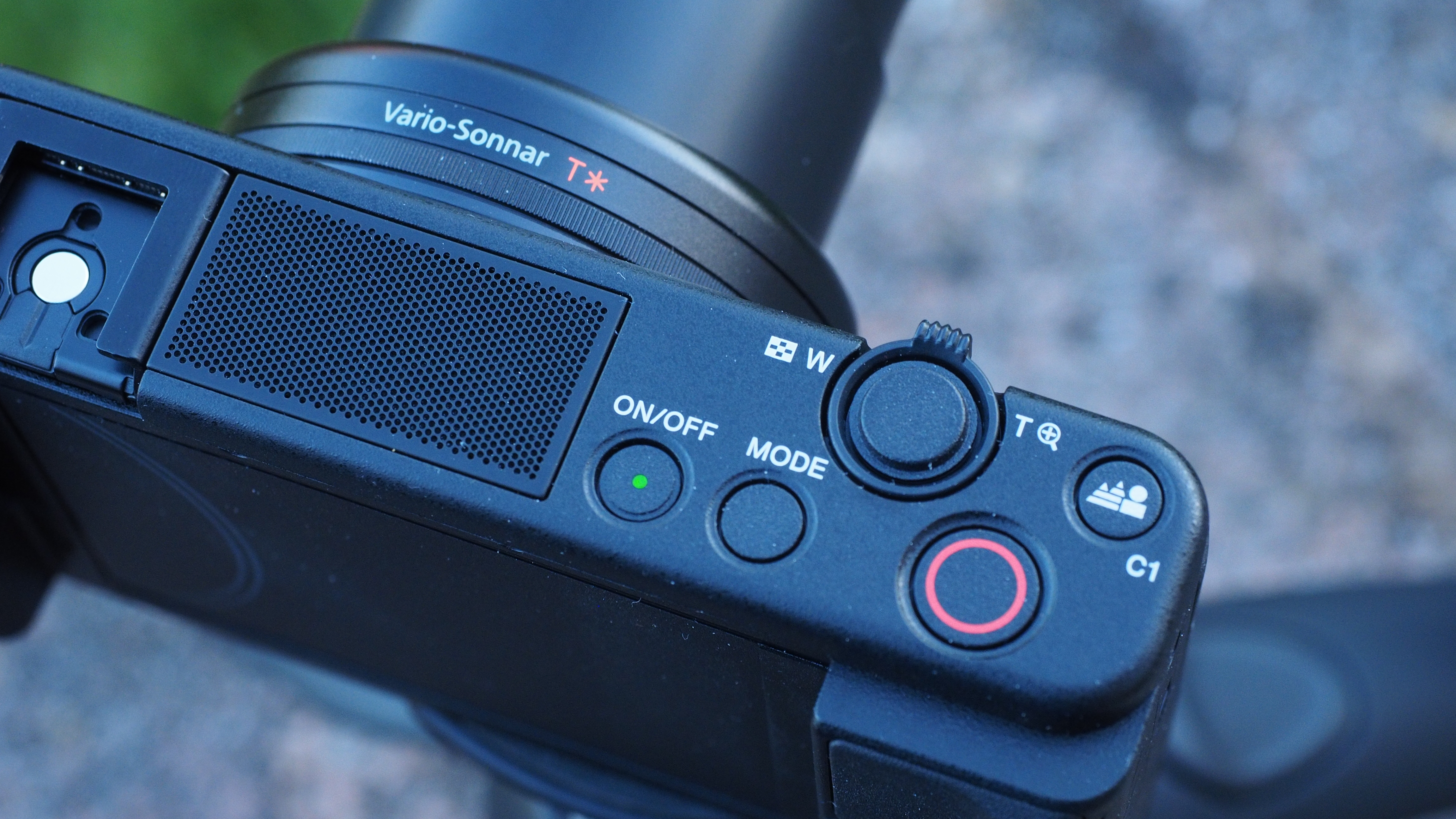Digital Camera World Verdict
It would be easy dismiss the ZV-1 as yet another Sony RX100 variant, but it’s much more than that. The sensor and lens might be familiar, but the body, the controls, the audio and the rear screen are all new and different and optimised brilliantly for vlogging. It's not without faults, but the ZV-1's design and its price are very refreshing.
Pros
- +
Vari-angle rear screen
- +
Clip on wind shield
- +
Brilliantly fast AF
- +
Compact size
Cons
- -
Min focus varies with zoom
- -
Stabilization seems pretty jerky
- -
Why a 3:2 screen and not 16:9?
- -
Lacks front-facing touch control
Why you can trust Digital Camera World
The Sony ZV-1 hits the spot perfectly. We liked it a lot when it was launched and we still like it now. There are lots of stills cameras that are also pretty good at vlogging, and a few that the makers have specially adapted with flip-over screens, mic sockets and face/eye detect AF.
The ZV-1 stands out, however, as a camera that has been built for vlogging first and foremost. It will also shoot stills perfectly well, but vlogging is what it’s made for. This makes it a strong candidate for our list of the best cameras for vlogging, and it also qualifies for our list of the best Sony cameras. Its nearest rival is the Canon PowerShot G7 X Mark III, but the new Sony beats it for screen articulation, autofocus and audio. It's also cheaper than the flagship Sony RX100 VII, and by a considerable margin.
Since then, Sony has taken the same idea to its swelling A6000 mirrorless camera range to produce the ZV-E10. Like the ZV-1, the ZV-E10 takes an existing (and increasingly expensive) range and produces a cheaper vlogging specific version that feels a much better fit for its audience.
The difference is that the ZV-1 is a compact camera with a smaller 1-inch sensor and a fixed, non-interchangeable lens. This is a 24-70mm equivalent f/1.8-2.8 zoom similar to that used on older Sony RX100 models, and the sensor is a 20MP 1-inch type used across the RX100 range.
But apart from the technical similarities with other RX100 cameras and a broadly similar size and weight, the ZV-1 is a very different beast – both physically and operationally.
Specifications
Sensor: 20.1MP 1-inch Exmor RS CMOS sensor
Image processor: BIONZ X
AF points: 315/425 point hybrid phase/contrast AF
ISO range: 100 to 12,800 (exp 64-12,800)
Max image size: 5,472 x 3,648
Metering modes: Multi-pattern, centre-weighted, spot, average, highlight
Video: 4K UHD at 30/25p
Viewfinder: No
Memory card: 1x SD/SDHC/SDXC (UHS I)
LCD: 3-inch vari-angle touchscreen, 921k dots
Max burst: 24fps
Connectivity: Wi-Fi, Bluetooth
Size: 105.5 x 60.0 x 43.5mm
Weight: 294g (with battery and memory card)
Key features
Three features on the Sony ZV-1 immediately stand out. First, it has a fully vari-angle screen, when Sony usually sticks to simpler tilting screens. The vari-angle pivot is especially suitable for shooting video vertically. Purists will shudder, but vertical video is what you need if your vlogs are designed for consumption on a smartphone.
The best camera deals, reviews, product advice, and unmissable photography news, direct to your inbox!
Second, there’s a much larger than usual microphone grille on the top plate. The internal mic has been optimised for voice recording, and for the attachment of a custom-designed wind shield. This is included with the camera and clips in to the accessory shoe alongside the mic and covers it with a furry baffle.
Third, there’s a new ‘product showcase’ AF mode which will switch focus to any object you hold up to the camera while you’re talking. This, and a new ‘bokeh background defocus’ switch will help amateur video makers get cinematic background blur and focus pull effects without being bothered by technicalities.
The ZV-1 does not have the integral electronic viewfinder of the Sony RZ100 series cameras. Neither does it have a flash, or even a mode dial. Stills shooters needn’t despair, however – all the regular shooting modes are still there and accessed by a Mode button.
The ZV-1 offers the same 20MP image quality as the Sony RX100 cameras, so if it helps you can think of those as being stills cameras that can shoot video, and the ZV-1 as a vlogging camera that can also shoot great stills.
The fixed lens is no handicap if you're the sort of shooter that works in a regular 'kit lens' focal range anyway, though if you want to film yourself and your background, that 24mm equivalent wide-angle view may not be quite wide enough – this is where an interchangeable camera like the Sony ZV-E10 and the option of fitting a wide-angle lens is an advantage.
Having said that, holding the ZV-1 at arm's length to shoot a selfie video doesn't demand a lot of muscle. Doing the same with a ZV-E10 and the Sony 10-18mm, for example, is a different proposition.
Build and handling
If you like your cameras small, the ZV-1 is for you. It’s very pocket or bag friendly and there is a grip on the right side of the body to give your fingers a bit more purchase. It’s better for small hands than big ones, though, and with much of the back taken up by the vari-angle screen, there’s room for only four small buttons and a dual function control/four-way navigation dial – this is the only control dial on the camera.
The rear screen is good, but it’s in the 3:2 ratio rather than the 16:9 ratio used for video. It’s touch-sensitive, but not for all controls. You can tap the screen to set a focus tracking point but for camera settings you need to use the navigational controller and central ‘OK’ button.
You probably won't notice or care particularly when shooting normally, but if you flip the screen around to record a piece to camera, the lack of touch-screen settings control suddenly becomes annoying.
The ZV-1 does not have the control ring around the lens that you find on the similar-sized RX100 models. There’s no electronic viewfinder, either, but that’s a pretty low priority for vlogging anyway.
On the top is a big and prominent video record button, on/off and Mode buttons and a smallish shutter release with a zoom lever around the outside.
All round, the ZV-1 is a very nice size for carrying, but perhaps a fraction small when it comes to handling and controls. You can’t have everything!
Performance
Sony really has tuned its AF system perfectly for its audience. The Real-Time Eye AF tracking is uncanny in its accuracy and speed, and the product showcase AF just brings a smile to your face when you use it because of its speed and the professional look of its fast but smooth refocusing action (if it’s too fast, you can slow it down).
It’s like Sony has asked a vlogger to sit down in front of the camera and show them what they do – and then designed a camera to do that perfectly.
If you can sit through 60 seconds of ham-fisted amateur vlogging, this is what it looks like!
Click the image above to watch the video of the Sony ZV-1 autofocus in operation
It’s also just as good for stills photography as the regular RX100 cameras. You don’t get the extended zoom range of the latest RX100 models or the built-in electronic viewfinder – or a mode dial – but these are not serious issues in a camera where stills photography is secondary.
The audio features are interesting. It’s hard to say whether the voice-optimised sound recording makes too much difference to speech, but the wind shield makes a huge difference. We tried it out on a breezy day, and without the shield the wind noise made the audio unusable, but with it, we couldn’t hear any wind noise at all.
Sony is keen to provide the kind of audio quality that makes an external mic unnecessary – which works to a point, but not when the speaker is a few feet from the camera. There will be times when you need an external mic regardless, and the ZV-1 does have a mic socket for those times.
We’re not so sure about the SteadyShot Active stabilization, which Sony says is up to 11x better than standard stabilization. Our run and gun tests came out pretty jerky and unpleasant to watch… but Sony will also be offering a VPT2BT accessory grip (and a smaller SGR1 grip). The VPT2BT should steady up your video a little, or you could opt for a stabilized gimbal instead – the ZV-1’s light weight means you won’t have to go too far up-market.
Verdict
Some might dismiss the ZV-1 as yet another Sony RX100 variant, but it’s much more than that. The sensor and lens might be familiar, but the body, the controls, the audio and the rear screen are all new and different and optimised brilliantly for vlogging.
There are a couple of niggles. The huge change in the minimum focus distance when you zoom in is annoying and the SteadyShot Active stabilisation didn’t work too well for us, but the autofocus is exceptional and the ZV-1 is a joy to use, not least because here at last is a vlogging camera that really is designed specifically for vlogging.
Is it better or worse than a mirrorless camera, like the newer Sony ZV-E10? It's worse for ultimate image quality and versatility maybe, but it's smaller, cheaper and more portable – and if that's what you need, then the ZV-1 is, frankly, the better camera.
Read more:
• These are the best cameras for vlogging right now
• We pick the best Sony cameras to buy
• Getting serious? These are the best cameras for filmmakers
• Best DSLR gimbals for mirrorless and SLR cameras

Rod is an independent photography journalist and editor, and a long-standing Digital Camera World contributor, having previously worked as DCW's Group Reviews editor. Before that he has been technique editor on N-Photo, Head of Testing for the photography division and Camera Channel editor on TechRadar, as well as contributing to many other publications. He has been writing about photography technique, photo editing and digital cameras since they first appeared, and before that began his career writing about film photography. He has used and reviewed practically every interchangeable lens camera launched in the past 20 years, from entry-level DSLRs to medium format cameras, together with lenses, tripods, gimbals, light meters, camera bags and more. Rod has his own camera gear blog at fotovolo.com but also writes about photo-editing applications and techniques at lifeafterphotoshop.com









